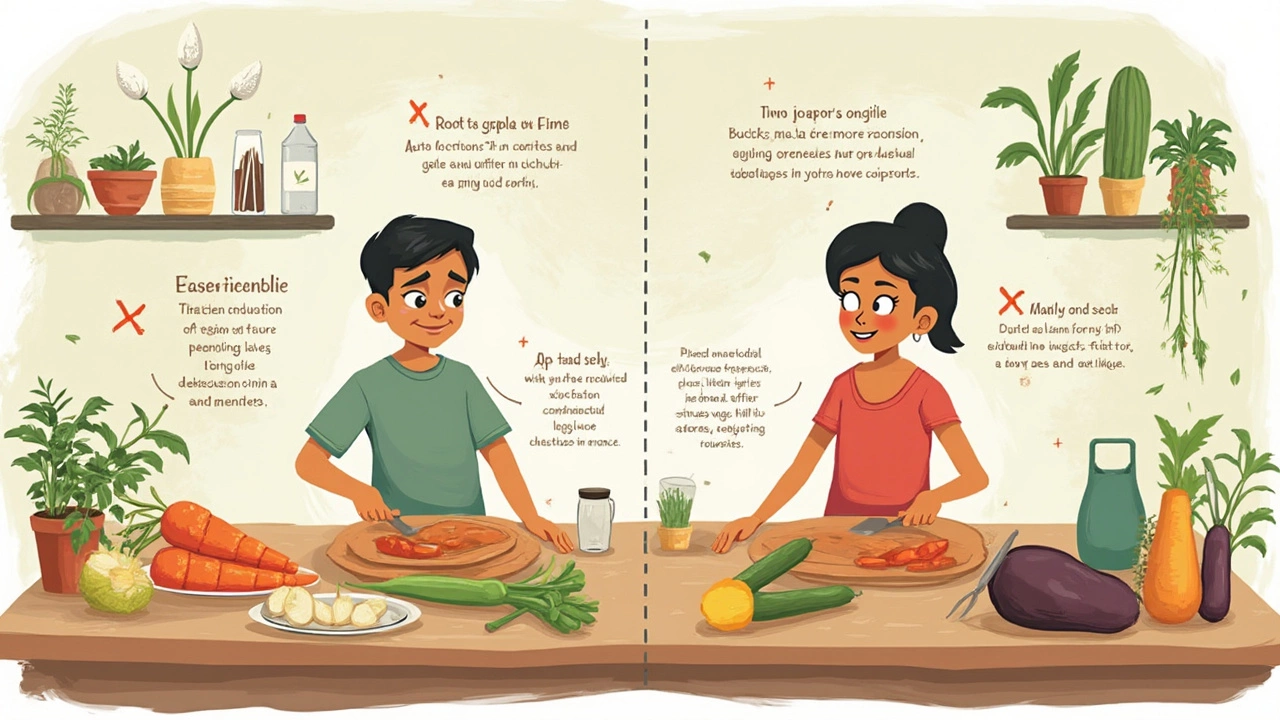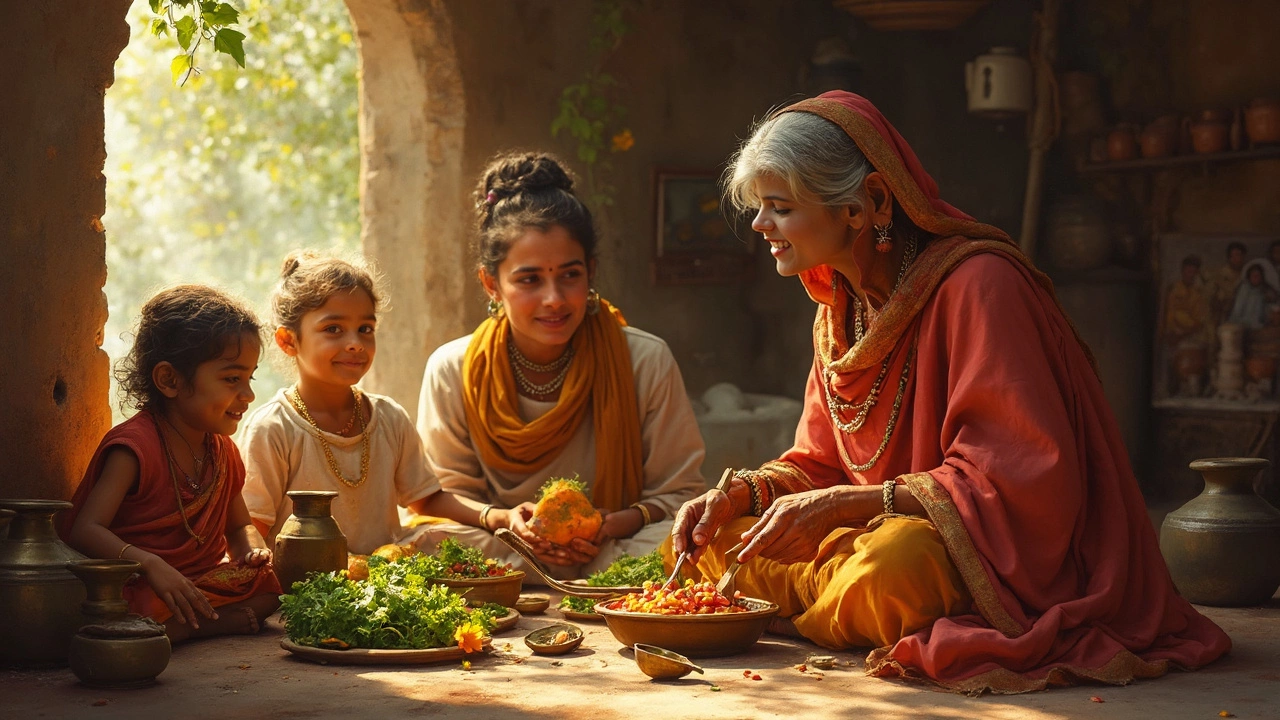Ever wondered why carrot sticks never show up at a Jain dinner? It’s not just about tradition—there’s a strong belief system guiding what goes onto their plates. For Jains, every food choice ties back to ahimsa, or non-violence. This isn't just about avoiding meat or eggs, like you find in other vegetarian diets. It's way more detailed, and it touches on the humble carrot in a way most people have never realized.
Instead of going with what’s easy or popular, Jains ask: Will eating this harm any living thing? That question is exactly why root vegetables like carrots, onions, garlic, potatoes, and beets are left off the menu. But it’s not only about the veggies themselves—digging up roots is believed to disturb and destroy tiny forms of life in the soil. Even the plant itself often dies when you harvest its root. Sounds intense? It’s actually a pretty creative and thoughtful approach to daily eating.
- Jain Food Philosophy Explained
- Root Vegetables: The Main Issue
- Why Carrots and Other Roots Are Off the Menu
- Practical Tips for Jain Cooking
- Everyday Dishes Without Carrots
Jain Food Philosophy Explained
Jain food rules are some of the strictest in the world when it comes to vegetarian eating. They're not made up on the go—these ideas are built on Jainism’s core values, especially ahimsa, or non-violence. This means trying to cause as little harm as possible to any living thing, right down to microbes you can’t see.
Here’s what that looks like day-to-day:
- No animal products at all—no meat, no fish, no eggs. That’s standard for vegetarians too, but Jains go many steps further.
- No honey either, because collecting it harms bees.
- No root vegetables—like carrots, potatoes, garlic, and onions—because pulling them up disrupts tiny living things in the soil and usually kills the plant itself.
- Some Jains even avoid eating after sunset to avoid accidentally harming insects that might be attracted to light and food.
This isn’t just about personal habits. Jainism actually encourages people to ask questions about how their food gets to the plate. Here’s a quick comparison table that makes things clear:
| Diet Type | Animal Products Allowed? | Root Vegetables Allowed? | Other Key Limits |
|---|---|---|---|
| Standard Vegetarian | No | Yes | None specific |
| Vegan | No (including dairy, eggs, honey) | Yes | No animal products at all |
| Jain | No | No | No certain pungent vegetables, no honey, sometimes no eating after dark |
Jains see meals as more than just fuel—it’s a daily chance to practice their ethics. While this means making careful choices, it also shapes a unique and pretty creative food culture. Jain cuisine, for example, gets by just fine without onions, garlic, or carrots, and it still tastes amazing. That’s why you’ll find Jain versions of popular Indian dishes all over cities like Mumbai, Delhi, and Ahmedabad.
Root Vegetables: The Main Issue
This is where things get really interesting. Root vegetables aren’t just another category on a grocery list if you follow Jainism. Pulling a carrot or potato out of the ground isn’t as simple as you think—it’s actually a pretty big deal for Jains because it goes against their deepest value: non-violence toward all life forms.
Every time someone harvests a root vegetable, they kill the entire plant. That’s different from picking a tomato or plucking spinach leaves, where the rest of the plant still grows. For Jains, this act can harm loads of tiny organisms living in the soil. The soil is full of microscopic life—think bacteria, insects, and all sorts of tiny critters you can't see with your eyes. Digging up roots disrupts that whole hidden world. That’s why root vegetables, including carrot, get skipped in Jain kitchens. It’s more than what’s on your plate—it’s about protecting ecosystems most people never think about.
Here’s a quick look at common root veggies and why they’re avoided:
- Carrots – killing the plant and disturbing soil life
- Potatoes – same reason, plus tendency to carry soil microbes
- Onions and garlic – plant destruction and extra strong impact on tiny soil organisms
- Beets and radishes – uprooting equals loss of life both for the plant and soil critters
Want to get a sense of just how big a part root veggies play in Indian diets? Check out these numbers:
| Vegetable | Annual Production in India (Million Tons) |
|---|---|
| Potato | 54 |
| Carrot | 1.8 |
| Onion | 26 |
| Garlic | 2.9 |
That’s a lot of food off the menu for strict Jains! Instead, they stick to foods that don’t end a plant’s life or disrupt what’s happening below ground. This approach means getting creative in the kitchen—but also sticking with a clean conscience.

Why Carrots and Other Roots Are Off the Menu
The big reason Jains won’t touch carrots, potatoes, or anything that grows underground comes down to ahimsa, or non-violence. Pulling a root vegetable out of the soil doesn’t just kill the plant—it disturbs tons of little microorganisms, insects, and sometimes even the whole web of life in that small patch of dirt. Jains see this as unnecessary harm. They go way beyond just avoiding meat—roots just aren’t worth the extra life lost, in their eyes.
Digging up roots often means the plant can’t grow back; it’s gone for good. Compare that to picking fruit or leaves, where the tree or bush keeps living. Jains prefer foods that let plants carry on, like beans, grains, lentils, and above-ground veggies. That means no scraping out carrots for salads, mashed potatoes, or even a quick veggie stir fry, if you’re going all-in on a Jain menu.
Here’s a quick look at some foods that don’t make the cut in traditional Jain kitchens:
- Carrots
- Potatoes
- Onions
- Garlic
- Beets
- Radishes
You might be surprised just how carefully this is practiced. Even Jain restaurants in big Indian cities avoid these ingredients completely to honor those who take the diet seriously. In fact, according to a 2022 survey of Indian urban eating habits, over 95% of Jain restaurants have zero root vegetables in their kitchen:
| Ingredient | Allowed in Jain Diet? |
|---|---|
| Carrots | No |
| Potatoes | No |
| Onions | No |
| Garlic | No |
| Lentils | Yes |
| Apples | Yes |
This way of eating isn't some old-fashioned rule—it's a lived commitment. If you’re curious how strict some places get, just peek at any menu in a Jain-friendly spot. You won’t see a single root veggie listed. It’s all about that strong sense of Jainism and sticking to non-violence all the way down to what’s on your plate.
Practical Tips for Jain Cooking
If you’re new to Jain cooking, you might feel lost without carrots, onions, or potatoes. But plenty of tasty options are waiting once you get the basics down. Here’s what helps most people adjust—and even get creative—in a Jain kitchen.
- Plan meals around seasonal, local veggies that grow above the ground. Think about things like tomatoes, bell peppers, spinach, cabbage, and green beans. These are staples in Jain households because harvesting them doesn’t kill the plant.
- Skip roots and bulbs in recipes by swapping with favorites like pumpkin, bottle gourd (lauki), or ridge gourd (turai). These deliver texture and bulk without breaking the Jain rule on root veggies.
- For flavor, use hing (asafoetida), ginger powder (dry, not fresh root), cumin, mustard seeds, curry leaves, and coriander. Onions and garlic are out, but a smart blend of spices brings out amazing flavors.
- Double-check packaged foods for hidden roots or non-vegetarian enzymes. Labels like "pure veg" or "Jain-friendly" make shopping easier, especially in major Indian grocery stores.
- Batch prepping saves lots of time. Chop veggies, pre-make gravies (minus root veggies), and freeze portions so you’re set for the week.
Many newcomers ask: "How do you get enough variety without potatoes or carrots?" Actually, Jain meals cover loads of different tastes and nutrients. Check out this handy table for some quick swaps:
| Common Non-Jain Ingredient | Jain Substitute | Popular Recipe Example |
|---|---|---|
| Carrot | Papaya or pumpkin | Gajar ka halwa ➔ Papaya halwa |
| Potato | Raw banana, yam, or paneer | Aloo subzi ➔ Raw banana subzi |
| Onion | Cabbage or fennel, extra hing | Onion-tomato gravy ➔ Tomato-ginger gravy |
| Garlic | Asafoetida (hing), ginger powder | Lasooni dal ➔ Hing-ginger dal |
Prepping Jain meals takes a little readjustment, but you’ll quickly find your groove. Plus, you’ll pick up tasty new ideas for your regular vegetarian dishes, even if you’re not following Jain rules every day.

Everyday Dishes Without Carrots
If you're skipping carrots—like Jains do—that doesn't mean your meals turn boring or bland. Jain home kitchens are loaded with veggie-based dishes, just minus all root vegetables. One of the all-time favorites is cabbage sabzi, which uses chopped cabbage, peas, and a simple mix of spices. It's quick and totally fills your plate with flavor and crunch.
Another classic is Jain dal. You make it with lentils, tomatoes, green chilies, and cumin, but leave out anything that grows underground. The taste? Surprisingly rich and comforting. Jain undhiyu (a Gujarati mixed vegetable dish) is made only with veggies like eggplant, unripe bananas, and beans—no potatoes or carrots. And for a snack, you can't beat khaman dhokla, a steamed, fluffy chickpea cake that pairs perfectly with green chutney.
Here's a peek at some top Jain-friendly dishes and their main ingredients:
| Dish Name | Main Ingredients | Carrot-Free? |
|---|---|---|
| Cabbage Sabzi | Cabbage, peas, turmeric, green chili | Yes |
| Jain Dal | Yellow lentils, tomato, cumin | Yes |
| Khaman Dhokla | Chickpea flour, yogurt, green chili | Yes |
| Undhiyu (Jain version) | Eggplant, green beans, raw banana | Yes |
| Bhindi Masala | Okra, tomatoes, spices | Yes |
If you want to get creative in your own kitchen, here are a few tips:
- Swap out carrots for bell peppers, green beans, or squash. They all give color and crunch.
- Skip potatoes in curries and use unripe bananas or bottle gourd instead.
- Most dishes just need a little more of the "allowed" veggies to keep the recipe balanced.
- Always double-check ingredients in ready-made spice mixes—some might have garlic or onion powder, which are also avoided.
It's all about mixing things up and knowing how to work with what you have. The Jain diet's approach makes you rethink everyday cooking and see how much flavor you can get from simple veggies. If you focus on the Jain way, you'll find that Jainism offers a refreshingly mindful and tasty path through vegetarian Indian cuisine.
